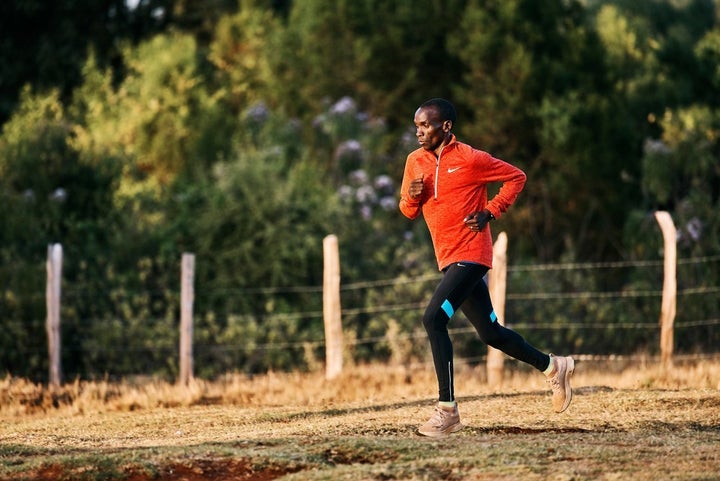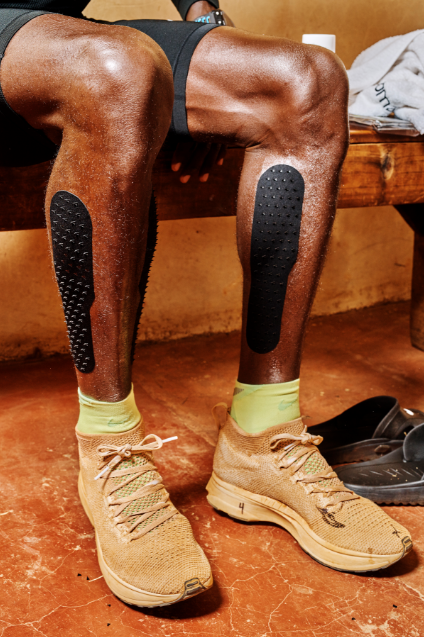By Ed Caesar for WIRED.

Eliud Kipchoge wears Nike’s customized Zoom Vaporfly Elites as he trains in Eldoret, Kenya to break the two hour mark. For his test run, our writer tested the consumer version of the shoe, the Zoom Vaporfly 4%.
Earlier this week, WIRED ran a story about the new Nike sneakers tied to Breaking2, the company’s attempt to help runners break the two-hour mark at a special marathon this spring. As part of WIRED’s exclusive look at that initiative, our writer took a trial run in the sneakers as part of his training to achieve his own personal milestone: a sub-90-minute half-marathon.
I thought we were talking about doping; Haile Gebrselassie thought we were talking about shoes. It was November 22, 2012, and we were sitting in Gebrselassie’s eighth-floor office in Addis Ababa, Ethiopia, on a warm afternoon, locked in a long discussion about the limits of a runner’s body. Gebrselassie is not only a double-Olympic gold medalist with two marathon world records to his name; he is also a gregarious and provocative aficionado of the sport.
So I asked him: What did he consider the best time a clean athlete could run for the marathon?
“You ask me, clean? No technology, no help? That is what Abebe Bikila ran in 1960. That was barefoot. The cleanest.”
Bikila was the first black African to win a gold medal at the Olympics, when he beat a stacked marathon field in Rome, in 1960, barefoot. He is a hero to many Ethiopians, and it was perhaps not surprising to hear Gebrselassie invoke his name. What did surprise me was Gebrselassie’s understanding of the word “clean.” To him, changes in footwear — not improvements in diet, or training, or pacing, or psychology, or the emergence of blood doping, or any number of other factors — explained most of the 12 minutes that have fallen from the marathon world record since 1960. In his view, the last pure marathon was an unshod marathon.
That conversation in Addis Ababa popped into my head on Tuesday afternoon, as I laced up a pair of Nike’s Zoom Vaporfly 4 percent shoes on the Formula 1 track outside Monza, Italy. These are the shoes I’ll be wearing in a few months when I attempt to break my goal of 90 minutes for the half-marathon. They are a mass-market, albeit expensive, version of the “concept car” shoe that Eliud Kipchoge, Zersenay Tadese, and Lelisa Desisa will wear when they make their sub-two-hour attempt — the Zoom Vaporfly Elite.
The Elites look alien and striking, with a smooth wedge of foam at their rear, like the bow of a racing yacht. The 4 percents are less otherworldly. They are sleek, with a suggestion of the Elite’s maritime lines, but they look more or less like running shoes. The juju is on the inside. By connecting a new type of foam to a stiff, spoon-shaped plate, Nike designers claim, the Vaporflys make a runner 4 percent more efficient than the best racing flats Nike or any other company has on the market. (That 4 percent number comes from Rodger Kram, an independent physiologist commissioned by Nike to test the Vaporfly.) If those numbers are right, the shoe should make Kipchoge and Tadese and Desisa 4 percent more efficient. It should make me 4 percent more efficient. Greater efficiency means you need less oxygen to move down the road. In short, a runner should go be able to go faster for longer in these shoes than in any others.
Laced Up, Ready to Run
Like any new running addict, I’m interested in going faster for longer. The whole purpose of training for my half-marathon is to break a time. But as soon as I put the shoes on, speed was not uppermost in my mind. I became distracted by more immediate and powerful sensations, the first being: I couldn’t stand up straight. Because of the forward tilt of the plate in the shoe, I was rocked off my heels, even at standstill. It’s actually easier to run in the shoe than to stand around talking in it. They’re like ski-boots that way. When I took off for a test lap around the 2.4-kilometer junior course at Monza, I had the oddest sensation of being pushed onto my toes.
Within a few hundred yards, I became accustomed to the aggressive new angle at which my feet now struck the ground. My torso stiffened a little. My legs flew out behind me. It was like I was running downhill. In that moment, it dawned on me that in my own, lumpen way, I was running more like a Kenyan than I ever had before: not pulling my body forward with my feet out in front, but pushing my feet out behind me. In Two Hours, my book about the quest to break the two-hour marathon, I described how one of the modern greats of the sport, Geoffrey Mutai, ran. He was, I wrote, “a paradigm of economy” who “doesn’t brake at all, or strain for forward movement. There is no tension in his arms. It’s as if he is on wheels, not legs.”
That’s what I felt in these shoes: as if I was on wheels, not legs. I may not have looked like Mutai or run as fast as him, but, for the nine minutes and 14 seconds I careened around Monza, I felt like him. I was also pretty fast — averaging roughly a six-minute mile — although it’s easy to be fast for less than 10 minutes. The real test will come this spring.
Unfair Advantage?
There has been plenty of blood spilled already about whether Nike’s Vaporfly shoes run afoul of international marathon regulations or offer their owners an unfair advantage. My view on this matter counts for little, but, from what I can see, these shoes break none of the (admittedly vague) rules about footwear design set by the International Association of Athletics Federations, which governs the sport. They also appear to be constructed from technologies that have existed for some years: responsive foam and carbon-fiber plates. As Stefan Guest, a senior designer on the team at Nike that created the Vaporfly, told me after I had worn them, the design’s success is in its mixture of elements: of how and where the plate sits in the foam. “The magic,” he says, “is in the geometries.”

A close up of Kipchoge’s Vaporfly Elites. He’s been running in some version of the shoe for the better part of a year.
I’ll leave the argument over fairness to the sport’s regulators, but the experience of wearing the shoes made me return to Gebrselassie’s ideas about what constitutes a “clean” marathon. For him, Bikila, barefoot in Rome, was the last clean race. To expand his line of argument, all shoes are dirty — a cheat, to some degree — because they cushion and propel runners. In that view, each new iteration of shoe design is another move away from pure sport. But Gebrselassie also saw technological advance as not only unstoppable, but welcome. After all, Bikila followed up his barefoot triumph in 1960 with another gold medal in 1964, when he set a new world record at the Tokyo games—wearing shoes. With his customary Klieg-light smile, Gebrselassie would happily admit that when he was at his peak, he wanted the best, fastest, “dirtiest” shoes his sponsor could make him. (That would have been Adidas, not Nike.)
I, too, want better shoes, but for slightly different reasons. The French cyclist Jean Bobet once wrote about ecstatic athletic experience, a state that American athletes might call the zone but Bobet calls la Volupté. It is “delicate, intimate and ephemeral. It arrives, it takes hold of you, sweeps you up and then leaves you again. It is for you alone. It is a combination of speed and ease, force and grace. It is pure happiness.”
As I have become more serious about running, I have returned to that passage many times. I now realize that I have often been striving toward a feeling similar to the one described by Bobet. I also imagine many of the sport’s adherents, all over the world, might admit the same, even if they did not describe it in such terms. Running’s popularity is poorly explained solely by its social or fitness benefits. Its allure is deeper than that. There are times when even an ungainly giraffe like me can experience speed and ease, force and grace. There are times when nothing else matters except the workings of your own body.
When those moments arrive, they are unforgettable. I am happy to report that Bobet’s Volupté descended on me when I was rounding the final bend at Monza at 11 miles an hour, all alone, mountains behind me, bright spring sky overhead, wind at my back, 800 yards of empty straightaway in front of me, chest proud, legs whirring, a spoon-like carbon-fiber plate beneath my feet. I don’t know whether the shoes I was wearing were clean. I know there couldn’t have been a cleaner feeling.
More from WIRED:
